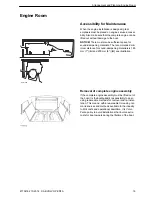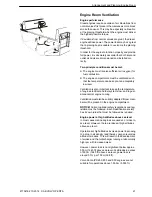
Dimensioning of air intake and ducts
The following basic facts must be considered in
calculations when planning an installation.
•
All combustion engines, regardless of manufacture
or type, require a certain amount of oxygen (or air)
for the combustion process. However, diesel
engines work with a somewhat larger air surplus
than gasoline engines.
•
Furthermore, all engines emit a certain amount of
heat to the surroundings, i.e. engine compartment.
•
Heat radiation is smaller on modern, compact
engines than on older, less compact engines. Mod-
ern engines enjoy a great advantage in this.
Ducts and pipes for inlet and outlet air
It is an advantage if ducts and pipes for inlet and outlet
air can be planned as early as the design stage, as they
can then be built into the hull or superstructure. This
eliminates the requirement for separate ducts.
It is relatively simple to design a system for providing
the engine with a sufficient quantity of combustion air,
but significantly more difficult to ventilate heat radiation
away.
The engine draws in air efficiently and naturally takes
it from whatever direction it can. If inlet and outlet ducts
are too small, the engine will draw in air from both ducts
and no ventilation air will be expelled through the outlet
duct. This will create dangerously high temperatures in
the engine compartment.
Most of the engine heat radiation must be carried away
from the engine compartment. It is a mandatory
requirement to keep engine compartment temperature
below the maximum permissible limit.
Fans
Normally
an extraction
(suction) fan must be installed
in the outlet duct to ventilate the engine compartment
more efficiently and thus keep engine compartment
temperature low.
Conversely, fans may never be installed in the inlet
duct as this may lead to engine compartment over-
pressure, with the risk of gases or air leaking into other
parts of the boat.
For diesel engines the fan may very well be thermostat
controlled; it must start at an engine compartment tem-
perature of 60 °C (+140 °F), measured in the
engine compartment.
NOTICE!
Fan hose connections for diesel engines
must be located as high in the engine compartment as
possible to carry away hot air, while for gasoline
engines as low as possible to carry away fumes.
Arrangement and Planning, Engine Room
22
47704162 10-2014 © AB VOLVO PENTA
Summary of Contents for IPS650
Page 1: ...IPS 2 IPS650 IPS800 IPS950 Installation 1 1 E ...
Page 2: ......
Page 156: ......
Page 160: ...47704162 English 10 2014 ...






























